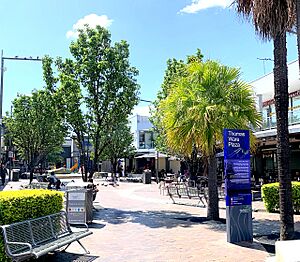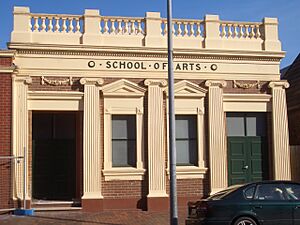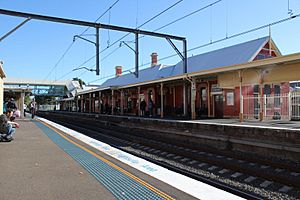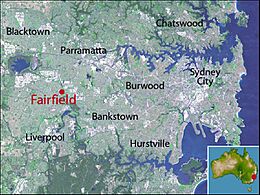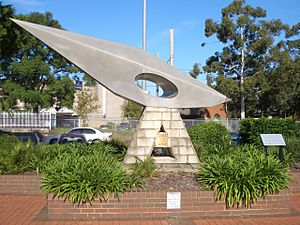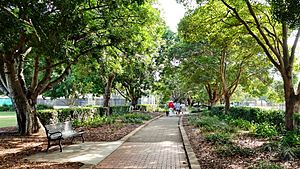Fairfield, New South Wales facts for kids
Quick facts for kids FairfieldSydney, New South Wales |
|||||||||||||||
|---|---|---|---|---|---|---|---|---|---|---|---|---|---|---|---|
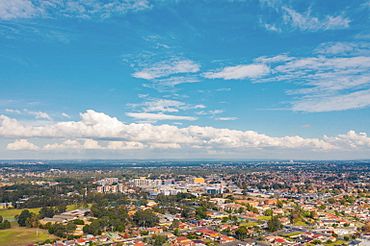
A bird's eye view of Fairfield
|
|||||||||||||||
| Population | 18,596 (2021 census) | ||||||||||||||
| • Density | 4,230/km2 (11,000/sq mi) | ||||||||||||||
| Established | 1807 | ||||||||||||||
| Postcode(s) | 2165 | ||||||||||||||
| Elevation | 15 m (49 ft) | ||||||||||||||
| Area | 4.4 km2 (1.7 sq mi) | ||||||||||||||
| Location | 30 km (19 mi) west of Sydney CBD | ||||||||||||||
| LGA(s) |
|
||||||||||||||
| State electorate(s) | Fairfield | ||||||||||||||
| Federal Division(s) | |||||||||||||||
|
|||||||||||||||
Fairfield is a suburb in Greater Western Sydney, New South Wales, Australia. It's about 30 kilometers west of the Sydney city center. Fairfield is the main hub for the Fairfield City Council.
Fairfield is known for being one of Australia's most multicultural places. More than half of the people living here were born overseas, often in countries where English isn't the main language. Many residents speak languages other than English at home, like Arabic and Assyrian Neo-Aramaic. Fairfield is especially home to many Assyrian Christians, often from Iraq and Syria. Because of its large Iraqi and Assyrian communities, Fairfield is sometimes called Little Iraq or Little Assyria.
Contents
Fairfield's History
For over 30,000 years, Aboriginal people from the Cabrogal-Gandangara tribe lived in the Fairfield area. They were the first inhabitants of this land.
European Settlement: Early Days
The first recorded European visit to the Fairfield area was noted in William Bradley's Journal. He explored Prospect Creek to see if it connected to Botany Bay. He found a spot where the water changed from fresh to salty, proving the creek linked to the sea.
In 1807, Gabriel Louis Marie Huon de Kerrileau, a French soldier, received 100 acres (about 40 hectares) of land in Fairfield. He named it Castel Paul, after his hometown in France. By 1814, this land, along with other grants, formed a large 700-acre (283-hectare) estate.
Growing Up: 1820s to 1920s
In 1814, John Horsley bought the estate and named it Mark Lodge. He was an important early settler in the Fairfield area. Later, Thomas Ware Smart bought the estate and built a grand house called 'Fairfield House' in the 1860s.
The Fairfield railway station opened in 1856. Its building is the oldest surviving railway building in New South Wales. The railway helped local businesses grow, including timber, fruit, and farm produce. By the early 1900s, about 2,500 people lived here, growing crops for Sydney. Electricity arrived in 1921.
Post-War Fairfield: 1940s to 1980s
After World War II, many soldiers returning home and European migrants settled in Fairfield. The population grew quickly. Ware Street became the main shopping street, even having the city's only escalator! It had stores for hardware, furniture, and clothes.
In the 1950s, many new homes were built by the Housing Commission, boosting the population to 38,000. The Civic Centre, with many businesses, was built in the 1960s. Fairfield Hospital opened in 1956 but moved to Prairiewood in 1988.
By 1979, Fairfield's population reached 120,000, making it one of the largest local government areas. In the early 1980s, Fairfield Forum shopping center opened. Ware Street was closed to cars and became a walking area with a fountain from Italy. However, this walking plaza didn't work out as planned, so Ware Street was later reopened to traffic.
Fairfield Today: 1980s to Now
During the Iran–Iraq War in the mid-1980s, many Assyrians left Iraq and settled in Fairfield. This made Fairfield a very popular place for Assyrian people to live. In 1990, Neeta City, another shopping center, opened because Fairfield's commercial area was growing fast.
In the mid-2000s, Fairfield saw its first tall apartment buildings (9-11 stories high) being built. More high-rise buildings followed in the city center.
In 2015, the Australian government offered special visas to people escaping war in the Middle East, especially from Syria. About 11,400 Iraqi and Syrian refugees, many of them Assyrian, came to Australia. Half of them settled in Fairfield and Liverpool. In 2016, Fairfield City welcomed 3,000 refugees, taking in 75% of all refugees in Western Sydney. Today, Fairfield City Centre has a mix of shops, businesses, and homes, including taller apartment buildings with shops on the ground floor.
In July 2021, Fairfield became a "hotspot" during the COVID-19 pandemic due to rising cases. The area went into a strict lockdown, and the city center became very quiet. Police checked that people were following the rules, and fines were given to those who didn't. Workers from Fairfield were told to stay home unless it was an emergency or they had a negative COVID-19 test.
Shopping and Fun in Fairfield
Fairfield's shopping area has a mix of street-side shops on Smart and Ware Streets, arcades, and larger shopping centers. You can find all sorts of things here: shops, cafes, restaurants, takeaways, and supermarkets. Some supermarkets even look like a bazaar (an open-air market)!
Fairfield doesn't have a traditional 'City Square', but The Crescent Plaza and Thomas Ware Plaza offer similar open spaces. While Fairfield isn't a big nightlife spot, wedding receptions do bring activity to the area on weekends.
Some shop fronts along The Crescent have old-fashioned styles from the late 1800s and early 1900s, showing how important this street used to be. The city center is surrounded by three-story apartment buildings, which help keep the streets busy with people walking around. The community loves to gather and interact, which you can see by the active shopping streets and people playing chess on Kenyon Street every day.
Fairfield has three main shopping malls that opened between the 1980s and early 1990s. The biggest ones are Fairfield Forum and Neeta City (now called Fairfield City Central). The smaller one is Fairfield Chase.
- Fairfield Forum has stores like Kmart, Aldi, and Coles.
- Fairfield City Central (formerly Neeta City) has a Woolworths supermarket.
- The Fairfield Chase Commercial Tower was Fairfield's first tall building. It has shops, a medical center, and food places on the lower levels. The upper levels are private office buildings for government groups like Legal Aid NSW and other companies.
The streets like The Crescent, Nelson, Ware, and Nelson Streets are lined with beautiful London plane trees.
Fairfield's Culture

A cinema called 'Hoyts Forum Twin' opened at Fairfield Forum in 1983. It had about 400 seats. It changed names a few times and eventually became the World Cinemas, mostly showing Bollywood films. The cinema closed in 2010, and the space is now a gym.
Fairfield is often linked with 'Assyrian' culture because many people overseas know it for its Assyrian culture. Many Iraqi and Assyrian businesses have opened in Fairfield, especially around Ware Street. These include everything from jewellery shops to restaurants, making the area a popular spot for the Iraqi and Assyrian community to shop and have fun. Older Assyrian men often gather daily to play dominoes at outdoor tables, which have chess boards printed on them.
Fairfield's diverse population means you can find over twenty different types of cafes and restaurants. You can try Assyrian, Iraqi, Italian, Chinese, Lebanese, Vietnamese, South American, and Thai food.
Sydney's Iraqi community often celebrates big events in Fairfield. For example, over 7,000 people celebrated in the streets of Fairfield in July 2007 when Iraq won the Asian Football Cup finals. Similar celebrations happened in January 2023 when Iraq won the 25th Arabian Gulf Cup.
Fairfield has a large public library on Hamilton Road. There are also several Assyrian churches, sporting clubs, cultural groups, and health organizations.
Fairfield's Heritage
The School of Arts Building, built in the late 1800s, is an important historical building. It shows styles from the Victorian and Federation periods, which are rare in the suburb. The Uniting Church is made up of two churches, built in 1894 and 1927. The first Fire Station in the city, on William Street, is also historically important. A weatherboard cottage (a small house) on Lawson Street was built around 1910.
Honour Avenue has two red brick entrance pillars and was built to remember Fairfield residents who served in the World Wars. It includes names of people from World War II. A metal arch above the pillars says: '1939 Honour Avenue 1945'. The avenue itself has large brush box trees and public seating.
Fairfield has several places listed for their historical importance:
- Fairfield railway station: This is the oldest railway station in New South Wales. Its buildings date back to 1856 and show Mid-Victorian and Georgian Style.
The International Monument in The Crescent Park was built in 1968 to celebrate Fairfield's migrant population. It was designed by Leonid Denysenko and Yurij Denysenko. The letter "A" stands for Australia and also Mount Ararat. The monument used to have water flowing like a waterfall. The angular shape above represents a boat or plane, and the hole in the middle symbolizes migrants arriving in a new land. The nearby LJ Clock Tower was put up in 1958.
Local News and Radio
Fairfield has two local newspapers, The Fairfield Advance and the Fairfield Champion, which come out every Wednesday. Fairfield Local News is an online news source for people in the Fairfield area. 2GLF is a community radio station that serves the communities of Liverpool and Fairfield.
Getting Around Fairfield
Fairfield railway station is on the Old Main South line. Trains run often from Fairfield to Leppington, Parramatta, and the City Circle (Sydney's city train loop). Fairfield also has a big bus interchange right next to the railway station. You can find details about bus services from the interchange at Fairfield railway station.
The Horsley Drive is a busy road in Fairfield, with lots of traffic. It's an important way to get into the city from the north and southeast. Hamilton Road to the southwest is another key road.
Schools in Fairfield
Fairfield has several schools for students.
- Public schools include Fairfield High School and Fairfield Public School.
- Private Schools include Patrician Brothers' College and Our Lady of the Rosary Primary School, both of which are catholic schools. Patrician Brothers' Primary School used to be in Fairfield but closed in 2006.
- Alternative High Schools for students who might need a different learning environment include Indie School - Fairfield campus, and Warakirri College - Fairfield campus.
Fairfield's Environment
Most of the original bushland (natural forest) in Fairfield has been cleared over time. However, a few small areas of this original bushland still remain. These include examples of Cumberland Plain vegetation and Cooks River/Castlereagh Ironbark Forest, which are protected under a special law for threatened species. You can often see Australian white ibis birds in The Crescent, across from the train station.
Eight creeks, totaling 80 kilometers in length, start in Fairfield City. They flow into the Georges River and Hawkesbury Nepean river systems. Over the past 50 years, development has caused damage to the natural habitat along the creek banks, and the water quality has been very poor. However, new plans are being put in place to fix this. The air quality in the city is affected by too many private cars, as the public transport system isn't fully connected yet.
Fairfield's Climate
Fairfield has a humid subtropical climate. This means it has hot, humid summers and mild winters. Summer weather can bring humid air from the northeast or dry air from the northwest. Fairfield is usually a few degrees warmer than Sydney city on summer days and a few degrees cooler on winter nights. There can be a big temperature difference between Fairfield and Sydney city, sometimes up to 10 degrees Celsius, because sea breezes don't usually reach inland areas like Fairfield. Fairfield also gets less rain each year than Sydney city, about 400mm less. The driest times are late winter and early spring, while late summer and autumn get more rain.
Who Lives in Fairfield? (Demographics)
According to the 2021 census, Fairfield had 18,596 people living there. Most of them (67.3%) were born outside of Australia.
- Where people are from
The largest groups of people born overseas came from Iraq (22.6%), Vietnam (9.8%), Syria (8.3%), China (2.7%), and Cambodia (2.1%).
- Languages spoken
Only 16.0% of people spoke English as their only language at home. The most common languages spoken other than English are Arabic at 16.7% (mostly Iraqi Arabic and Syrian Arabic), Assyrian Neo-Aramaic at 15.2%, Vietnamese at 12.0%, Chaldean Neo-Aramaic at 5.9%, and Mandarin at 3.0%. If you combine Assyrian and Chaldean languages, then Neo-Aramaic is the most common language at 21.1%.
- Ethnic backgrounds
The most common ethnic groups are Assyrian (15.5%), Vietnamese (11.2%), Chinese (10.2%), Iraqi (10.1%), and Australian (6.9%).
- Religions
The most common religions reported were Catholic (31.1%), No Religion (11.8%), Buddhism (11.7%), and Islam (8.5%). Overall, Christianity was the largest religious group (61.8%).
- Families and Homes
- 47.2% of families were couples with children.
- 24.9% were couples without children.
- 24.6% were one-parent families.
- Of people over 15, 45.5% were married, and 13.3% were either divorced or separated.
- Most households (74.4%) were family households.
- Types of Homes
- 40.0% of homes in Fairfield were separate houses.
- 13.4% were semi-detached houses or townhouses.
- 46.0% were apartments.
- 21.0% of homes were owned, and 57.5% were rented.
Sports and Recreation
Fairfield Adventure Park, a big playground for older kids and teens, opened in April 2015. Nearby are the Fairfield Youth and Community Centre and the Fairfield Leisure Centre, which is an aquatic centre (a place with swimming pools). These places are all located in Fairfield Park Precinct, a large urban park and sports ground. Prospect Creek flows through this park.
Fairfield is also home to the Fairfield Bulls and Fenix FCS football (soccer) clubs.
The Crescent Park is next to the train station. It has public seating surrounded by native and exotic plants. Another green space is the David Carty Reserve, a small, round island of land surrounded by Fairfield Street and The Horsley Drive. It has many large Hill's weeping figs and camphor trees, which are introduced evergreen trees from East Asia.
Notable People from Fairfield
Fairfield has been home to many well-known people, including:
- Mark Bosnich, Australian Socceroos (national soccer team) player
- Mitchell Claydon, Australian-English cricketer
- Jelena Dokić, Australian tennis player
- Jon English, singer, songwriter, musician, and actor
- Blake Green, Australian rugby league player
- Evan Green, journalist
- Glenn Grief, Australian rugby league player
- Les Hill, Australian actor
- Justice Crew, winners of Australia's Got Talent in 2010
- Harry Kewell, Australian Socceroos player
- David Klemmer, Australian rugby league player
- Bing Lee, Founder of the Bing Lee electronics company
- Michael Masi, Formula One race director
- Bill Summerell, Australian rugby league player
- Donnie Sutherland, Journalist and television host
- Maria Tran, Actress, film director
- Kyle White, Australian rugby league player
- Gough Whitlam, 21st Prime Minister of Australia (1972 to 1975)
- Ruben Zadkovich, Newcastle Jets and Australian Socceroos player


